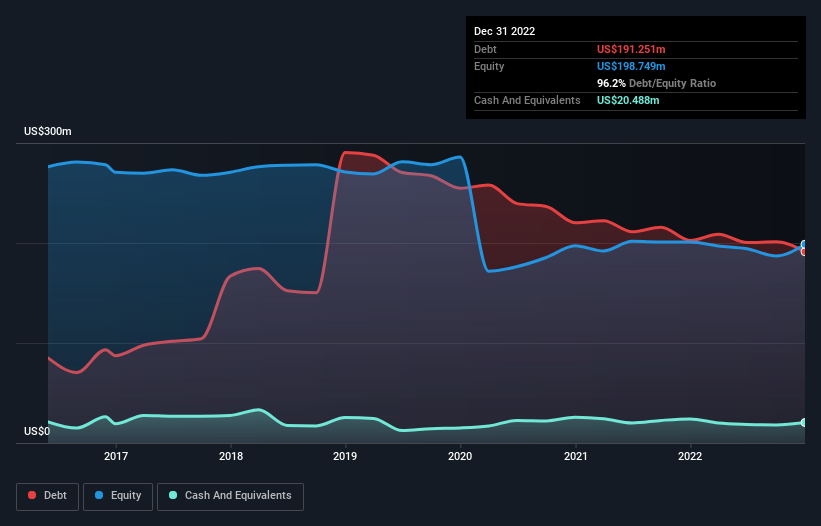Howard Marks put it nicely when he said that, rather than worrying about share price volatility, ‘The possibility of permanent loss is the risk I worry about… and every practical investor I know worries about.’ When we think about how risky a company is, we always like to look at its use of debt, since debt overload can lead to ruin. We note that Mistras Group, Inc. (NYSE:MG) does have debt on its balance sheet. But the real question is whether this debt is making the company risky.
When Is Debt Dangerous?
Debt and other liabilities become risky for a business when it cannot easily fulfill those obligations, either with free cash flow or by raising capital at an attractive price. In the worst case scenario, a company can go bankrupt if it cannot pay its creditors. However, a more common (but still painful) scenario is that it has to raise new equity capital at a low price, thus permanently diluting shareholders. By replacing dilution, though, debt can be an extremely good tool for businesses that need capital to invest in growth at high rates of return. The first step when considering a company’s debt levels is to consider its cash and debt together.
What Is Mistras Group’s Net Debt?
You can click the graphic below for the historical numbers, but it shows that Mistras Group had US$191.3m of debt in December 2022, down from US$202.6m, one year before. However, it does have US$20.5m in cash offsetting this, leading to net debt of about US$170.8m.
A Look At Mistras Group’s Liabilities
The latest balance sheet data shows that Mistras Group had liabilities of US$103.7m due within a year, and liabilities of US$232.4m falling due after that. On the other hand, it had cash of US$20.5m and US$123.7m worth of receivables due within a year. So it has liabilities totalling US$192.0m more than its cash and near-term receivables, combined.
This is a mountain of leverage relative to its market capitalization of US$199.0m. Should its lenders demand that it shore up the balance sheet, shareholders would likely face severe dilution.
We use two main ratios to inform us about debt levels relative to earnings. The first is net debt divided by earnings before interest, tax, depreciation, and amortization (EBITDA), while the second is how many times its earnings before interest and tax (EBIT) covers its interest expense (or its interest cover, for short). The advantage of this approach is that we take into account both the absolute quantum of debt (with net debt to EBITDA) and the actual interest expenses associated with that debt (with its interest cover ratio).
While Mistras Group’s debt to EBITDA ratio (3.5) suggests that it uses some debt, its interest cover is very weak, at 1.8, suggesting high leverage. It seems that the business incurs large depreciation and amortisation charges, so maybe its debt load is heavier than it would first appear, since EBITDA is arguably a generous measure of earnings. It seems clear that the cost of borrowing money is negatively impacting returns for shareholders, of late. Another concern for investors might be that Mistras Group’s EBIT fell 12% in the last year. If that’s the way things keep going handling the debt load will be like delivering hot coffees on a pogo stick. There’s no doubt that we learn most about debt from the balance sheet. But ultimately the future profitability of the business will decide if Mistras Group can strengthen its balance sheet over time.
Finally, while the tax-man may adore accounting profits, lenders only accept cold hard cash. So it’s worth checking how much of that EBIT is backed by free cash flow. Happily for any shareholders, Mistras Group actually produced more free cash flow than EBIT over the last three years. There’s nothing better than incoming cash when it comes to staying in your lenders’ good graces.
Our View
Mulling over Mistras Group’s attempt at covering its interest expense with its EBIT, we’re certainly not enthusiastic. But at least it’s pretty decent at converting EBIT to free cash flow; that’s encouraging. Once we consider all the factors above, together, it seems to us that Mistras Group’s debt is making it a bit risky. Some people like that sort of risk, but we’re mindful of the potential pitfalls, so we’d probably prefer it carry less debt. The balance sheet is clearly the area to focus on when you are analysing debt.







































